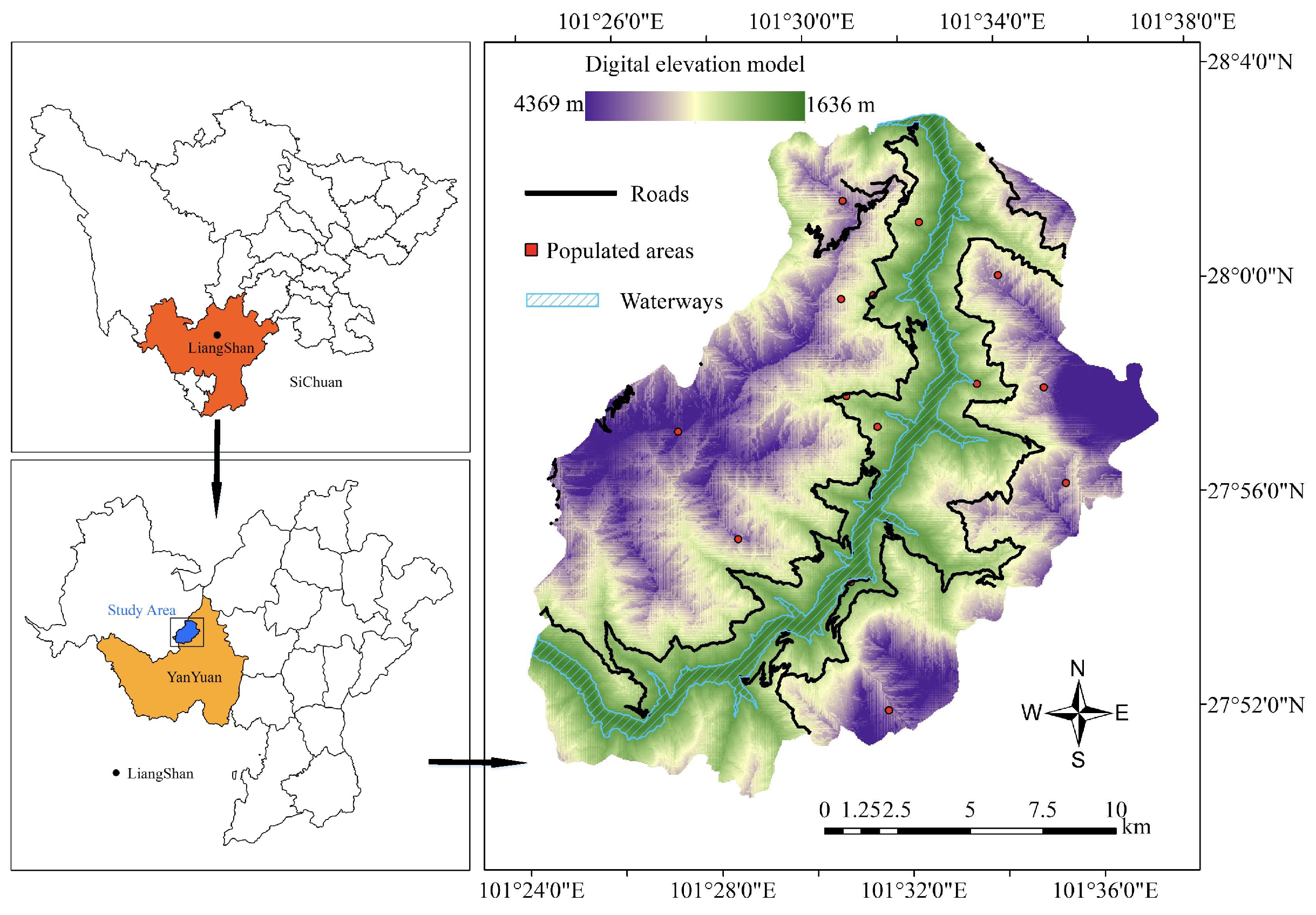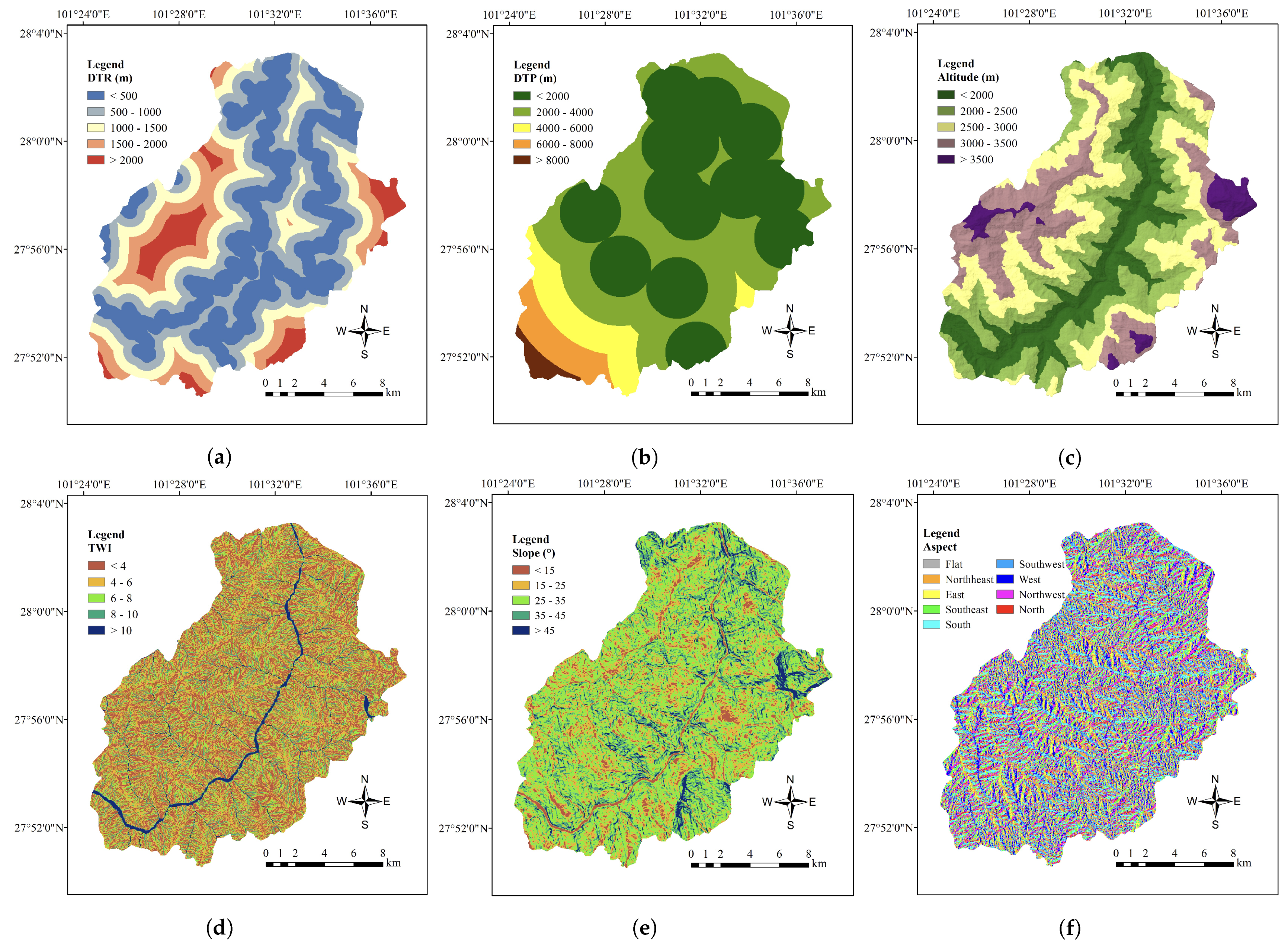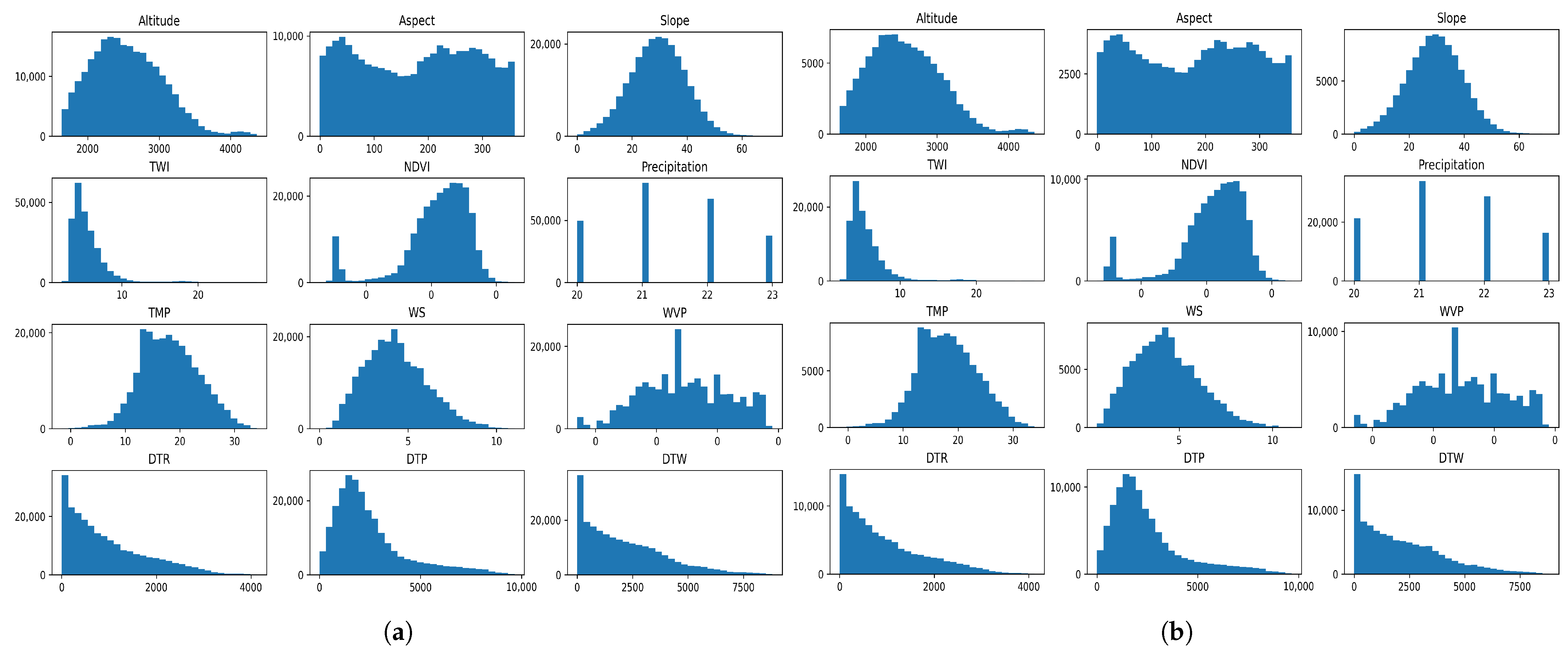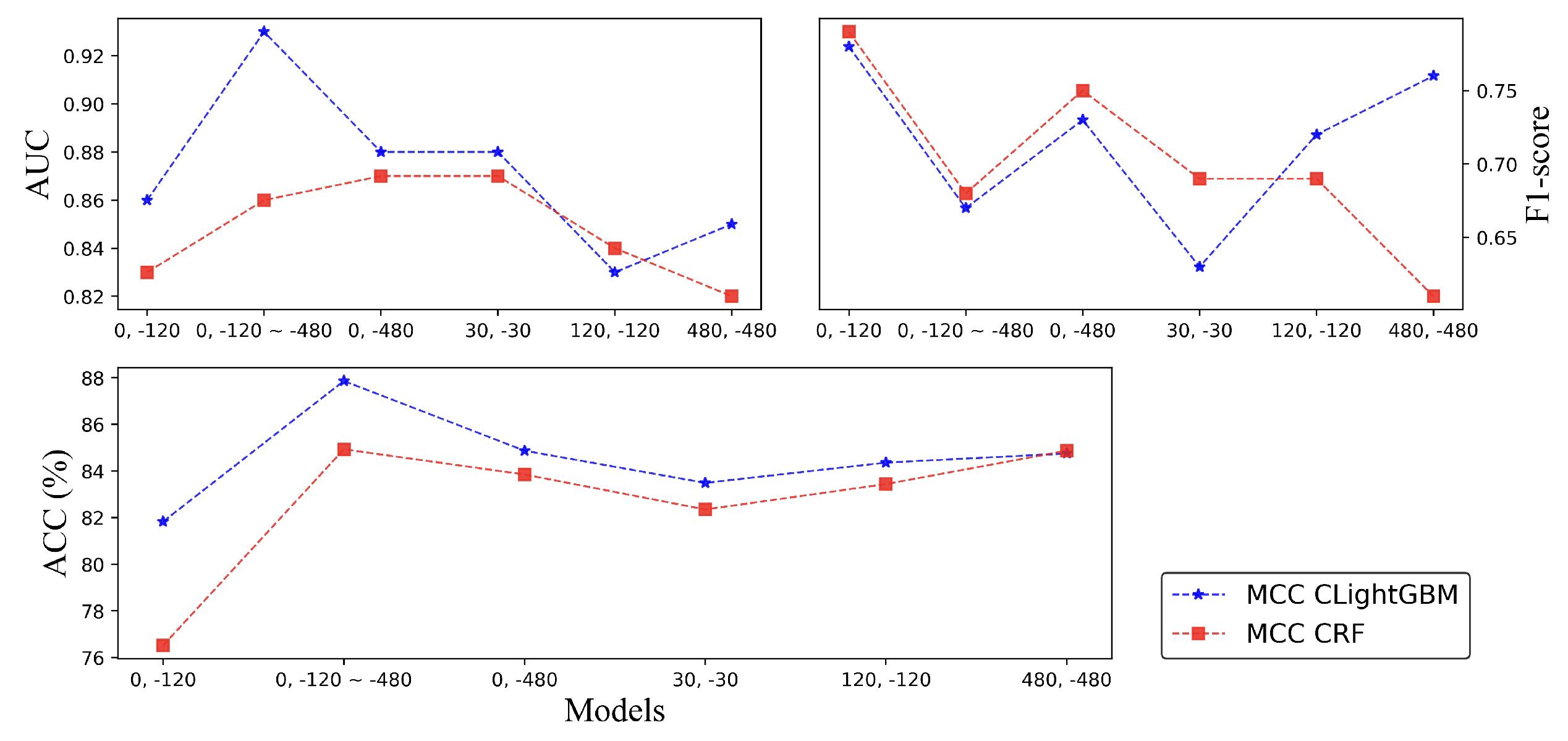Modeling Fire Boundary Formation Based on Machine Learning in Liangshan, China
Abstract
1. Introduction
2. Materials and Methods
2.1. Study Area
2.2. Sampling Design and Dataset
- The ’Case 0 m, Control −120 m Model’ uses data points at the fire boundary (0 m) as case data and data points 120 m within the burned area from the fire boundary as control data;
- The ’Case 0 m, Control −120 m∼−480 m Model’ employs data points at the fire boundary as case data and data points ranging from 120 m to 480 m within the burned area from the fire boundary as control data;
- The ’Case 0 m, Control −480 m Model’ utilizes data points at the fire boundary as case data and data points 480 m within the burned area from the fire boundary as control data;
- The ’Case 30 m, Control −30 m Model’ uses data points 30 m within the unburned area from the fire boundary as case data and data points 30 m within the burned area from the fire boundary as control data;
- The ’Case 120 m, Control −120 m Model’ employs data points 120 m within the unburned area from the fire boundary as case data and data points 120 m within the burned area from the fire boundary as control data;
- The ’Case 480 m, Control −480 m Model’ utilizes data points 480 m within the unburned area from the fire boundary as case data and data points 480 m within the burned area from the fire boundary as control data.
2.3. Statistical Modelling
3. Results
4. Discussion
4.1. Fire Environment Influence
4.2. Influence of the Sampling Distance on Model Performance
4.3. Fire Boundary Prediction Model
5. Conclusions
Author Contributions
Funding
Data Availability Statement
Conflicts of Interest
Abbreviations
| MCC CLightGBM | Matched case-control conditional light gradient boosting machine |
| MCC CRF | Matched case-control conditional random forest |
| TMP | Temperature |
| WS | Wind speed |
| WVP | Water vapor pressure |
| TWI | Topographic wetness index |
| NDVI | Normalized difference vegetation index |
| DTR | Distance to roads |
| DTP | Distance to populated areas |
| DTW | Distance to waterways |
| MODIS | Moderate resolution imaging spectrometer |
| DEM | Digital elevation model |
| VIF | Variance inflation factor |
| SCC | Spearman’s rank correlation coefficient |
| AUC | Area under the curve |
| ACC | Accuracy |
| S.E. | Standard error |
References
- Liu, H.; Xu, X. Exploring the ‘dark’ side of forest therapy and recreation: A critical review and future directions. Renew. Sustain. Energy Rev. 2023, 183, 113480. [Google Scholar] [CrossRef]
- Lin, J.; Lin, H.; Wang, F. A Semi-Supervised Method for Real-Time Forest Fire Detection Algorithm Based on Adaptively Spatial Feature Fusion. Forests 2023, 14, 361. [Google Scholar] [CrossRef]
- Barmpoutis, P.; Kastridis, A. Suburban Forest Fire Risk Assessment and Forest Surveillance Using 360-Degree Cameras and a Multiscale Deformable Transformer. Remote Sens. 2023, 15, 1995. [Google Scholar] [CrossRef]
- Liu, X.; Tong, Z. Uncertainty simulation of large-scale discrete grassland fire spread based on Monte Carlo. Fire Saf. J. 2023, 135, 103713. [Google Scholar] [CrossRef]
- Nur, A.; Kim, Y.; Lee, J. Spatial Prediction of Wildfire Susceptibility Using Hybrid Machine Learning Models Based on Support Vector Regression in Sydney, Australia. Remote Sens. 2023, 15, 760. [Google Scholar] [CrossRef]
- Zhang, Z.; Tan, Y.; Hong, R.; Zhao, Y.; Zhang, H.; Zhang, Y.; Li, Z. Experimental investigation of tunnel temperature field and smoke spread under the influence of a slow moving train with a fire in the carriage. Tunn. Undergr. Space Technol. 2023, 131, 104844. [Google Scholar] [CrossRef]
- Culler, E.; Livneh, B. A data-driven evaluation of post-fire landslide susceptibility. Nat. Hazards Earth Syst. Sci. 2023, 23, 1631–1652. [Google Scholar] [CrossRef]
- Esmaeili-Falak, M.; Benemaran, R. Ensemble deep learning-based models to predict the resilient modulus of modified base materials subjected to wet-dry cycles. Geomech. Eng. 2023, 32, 583–600. [Google Scholar]
- Tehrany, M.; Jones, S. A novel ensemble modeling approach for the spatial prediction of tropical forest fire susceptibility using LogitBoost machine learning classifier and multi-source geospatial data. Theor. Appl. Climatol. 2019, 1, 637–653. [Google Scholar] [CrossRef]
- Cuesta, R.; Gracia, M.; Retana, J. Factors influencing the formation of unburned forest islands within the perimeter of a large forest fire. For. Ecol. Manag. 2009, 258, 71–80. [Google Scholar] [CrossRef]
- Macauley, K. Modelling Fire Cessation in the Canadian Rocky Mountains. Master’s Thesis, University of Alberta, Edmonton, AB, Canada, 2020. [Google Scholar]
- Nicholas, A.; Paul, F.; Brion, R.; Retana, J. Evidence for scale-dependent topographic controls on wildfire spread. Ecosphere 2018, 9, e02443. [Google Scholar]
- Wu, Z.; Wang, B.; Li, M.; Tian, Y.; Quan, Y.; Liu, J. Simulation of forest fire spread based on artificial intelligence. Ecol. Indic. 2022, 136, 108653. [Google Scholar] [CrossRef]
- Ryzhkova, N.; Kryshen, A.; Niklasson, M.; Pinto, G. Climate drove the fire cycle and humans influenced fire occurrence in the East European boreal forest. Ecol. Monogr. 2022, 92, e1530. [Google Scholar] [CrossRef]
- Kolden, C.; Lutz, J.; Key, C. Mapped versus actual burned area within wildfire perimeters: Characterizing the unburned. For. Ecol. Manag. 2012, 286, 38–47. [Google Scholar] [CrossRef]
- Christopher, D.; David, E.; Matthew, P. An empirical machine learning method for predicting potential fire control locations for pre-fire planning and operational fire management. Int. J. Wildland Fire 2017, 26, 587–597. [Google Scholar]
- Cliff, H.; Catt, G.; Holmes, J. Right-way fire in Australia’s spinifex deserts: An approach for measuring management success when fire activity varies substantially through space and time. J. Environ. Manag. 2023, 331, 117234. [Google Scholar]
- Fabi, A.; Thampi, S. A trust management framework using forest fire model to propagate emergency messages in the Internet of Vehicles (IoV). Veh. Commun. 2022, 33, 100404. [Google Scholar] [CrossRef]
- Lin, H.; Tang, C. Analysis and optimization of urban public transport lines based on multiobjective adaptive particle swarm optimization. IEEE Trans. Intell. Transp. Syst. 2021, 23, 16786–16798. [Google Scholar] [CrossRef]
- Jeong, M. Grid-based Urban Fire Prediction Using Extreme Gradient Boosting (XGBoost). Sens. Mater. 2022, 34, 4879–4890. [Google Scholar]
- Dong, H.; Wu, H.; Sun, P.; Ding, Y. Wildfire Prediction Model Based on Spatial and Temporal Characteristics: A Case Study of a Wildfire in Portugal’s Montesinho Natural Park. Sustainability 2022, 14, 10107. [Google Scholar] [CrossRef]
- Macauley, K.; McLoughlin, N.; Beverly, J. Modelling fire perimeter formation in the Canadian Rocky Mountains. For. Ecol. Manag. 2022, 506, 119958. [Google Scholar] [CrossRef]
- Coop, J.; Parks, S.; Stevens-Rumann, C.; Ritter, S.; Hoffman, C. Extreme fire spread events and area burned under recent and future climate in the western USA. Glob. Ecol. Biogeogr. 2022, 31, 1949–1959. [Google Scholar] [CrossRef]
- Lei, M.; Cui, Y.; Ni, J.; Zhang, G.; Li, Y.; Wang, H.; Liu, D.; Yi, S.; Jin, W.; Zhou, L. Temporal evolution of the hydromechanical properties of soil-root systems in a forest fire in China. Sci. Total Environ. 2022, 809, 151165. [Google Scholar] [CrossRef]
- Cui, L.; Luo, C.; Yao, C.; Zou, Z.; Wu, G.; Li, Q.; Wang, X. The influence of climate change on forest fires in Yunnan province, Southwest China detected by GRACE satellites. Remote Sens. 2022, 14, 712. [Google Scholar] [CrossRef]
- Peng, Q.; Li, X.; Shen, R.; He, B.; Chen, X.; Peng, Y.; Yuan, W. How well can we predict vegetation growth through the coming growing season. Sci. Remote Sens. 2022, 5, 100043. [Google Scholar] [CrossRef]
- Singha, P.; Rani, R.; Badwaik, L. Sweet lime peel-, polyvinyl alcohol-and starch-based biodegradable film: Preparation and characterization. Polym. Bull. 2023, 80, 589–605. [Google Scholar] [CrossRef]
- Kok, J.; Storelvmo, T.; Karydis, V. Mineral dust aerosol impacts on global climate and climate change. Nat. Rev. Earth Environ. 2023, 4, 71–86. [Google Scholar] [CrossRef]
- Tahiri, A.; Meddich, A.; Raklami, A. Assessing the potential role of compost, PGPR, and AMF in improving tomato plant growth, yield, fruit quality, and water stress tolerance. J. Soil Sci. Plant Nutr. 2022, 22, 743–764. [Google Scholar] [CrossRef]
- Collar, N.; Earles, T. Unique challenges posed by fire disturbance to water supply management and transfer agreements in a headwaters region. J. Environ. Manag. 2023, 339, 117956. [Google Scholar] [CrossRef]
- Chen, C.; Zhang, Q.; Kashani, M.H.; Jun, C.; Bateni, S.M.; Band, S.S.; Dash, S.S.; Chau, K.W. Forecast of rainfall distribution based on fixed sliding window long short-term memory. Eng. Appl. Comput. Fluid Mech. 2022, 16, 248–261. [Google Scholar] [CrossRef]
- Zhao, J.; Zhang, X.; Zhang, J.; Wang, W.; Chen, C. Experimental study on the flame length and burning behaviors of pool fires with different ullage heights. Energy 2022, 246, 123397. [Google Scholar] [CrossRef]
- Gupta, B.; Agrawal, G.; Chauhan, A. Forest Fire: Characteristics and Management; Studera Press: Delhi, India, 2022; Volume 243, p. 143682. [Google Scholar]
- Abdo, H.; Almohamad, H.; Al-Mutiry, M. GIS-based frequency ratio and analytic hierarchy process for forest fire susceptibility mapping in the western region of Syria. Sustainability 2022, 14, 4668. [Google Scholar] [CrossRef]
- Sun, Y.; Zhang, F.; Lin, H.; Xu, S. A Forest Fire Susceptibility Modeling Approach Based on Light Gradient Boosting Machine Algorithm. Remote Sens. 2022, 14, 4362. [Google Scholar] [CrossRef]
- Zylstra, P.; Wardell-Johnson, G. Mechanisms by which growth and succession limit the impact of fire in a south-western Australian forested ecosystem. Funct. Ecol. 2023, 37, 1350–1365. [Google Scholar] [CrossRef]
- Munyati, C. Detecting the distribution of grass aboveground biomass on a rangeland using Sentinel-2 MSI vegetation indices. Adv. Space Res. 2022, 69, 1130–1145. [Google Scholar] [CrossRef]
- Adnan, R. Natural Disasters and Public Concern for Their Causes. Midang 2023, 1, 1. [Google Scholar]
- Schmidt, J.; Fensom, G.; Rinaldi, S.; Scalbert, A. Patterns in metabolite profile are associated with risk of more aggressive prostate cancer: A prospective study of 3,057 matched case–control sets from EPIC. Int. J. Cancer 2020, 146, 720–730. [Google Scholar] [CrossRef] [PubMed]
- Herbert, C.; Butsic, V. Assessing the effectiveness of green landscape buffers to reduce fire severity and limit fire spread in California: Case study of golf courses. Fire 2022, 5, 44. [Google Scholar] [CrossRef]
- Palaiologou, P.; Kalabokidis, K.; Day, M.; Kopsachilis, V. Evaluating socioecological wildfire effects in Greece with a novel numerical Index. Fire 2020, 3, 63. [Google Scholar] [CrossRef]
- Holsinger, L.; Parks, S.; Miller, C. Weather, fuels, and topography impede wildland fire spread in western US landscapes. For. Ecol. Manag. 2016, 380, 59–69. [Google Scholar] [CrossRef]
- Song, H.; Park, S. An analysis of correlation between personality and visiting place using Spearman’s rank correlation coefficient. KSII Trans. Internet Inf. Syst. (TIIS) 2020, 14, 1951–1966. [Google Scholar]
- Thapa, R. Evolution in Propellant of the Rocket Engine. J. Mater. 2016, 11, 8–21. [Google Scholar] [CrossRef]
- Ching, F. Building Construction Illustrated, 1st ed.; John Wiley & Sons: Hoboken, NJ, USA, 2020; pp. 324–325. [Google Scholar]
- Collins, L.; Bradstock, R.; Clarke, H. The 2019/2020 mega-fires exposed Australian ecosystems to an unprecedented extent of high-severity fire. Environ. Res. Lett. 2021, 16, 044029. [Google Scholar] [CrossRef]
- McAlpine, R.; Wotton, B. The use of fractal dimension to improve wildland fire perimeter predictions. Can. J. For. Res. 1993, 23, 1073–1077. [Google Scholar] [CrossRef]










| Clusters | Factors | Description | Data Range | |||
|---|---|---|---|---|---|---|
| Min | Max | Median | Mean | |||
| Topographic factors | Slope () | Slope = arctan (elevation difference/horizontal distance). | 0.00 | 71.05 | 29.42 | 29.32 |
| Aspect () | The orientation of the topographic slope. | 0.00 | 359.80 | 186.20 | 177.72 | |
| TWI | Wet and dry conditions of the soil. | 2.07 | 27.74 | 4.90 | 5.53 | |
| Altitude (m) | Height difference to sea level. | 1636.00 | 4369.00 | 2511.00 | 2557.39 | |
| DTW (m) | The distance to the nearest waterways. | 0.00 | 8817.19 | 1749.29 | 2142.84 | |
| Vegetation factors | NDVI | NDVI = (NIR − R)/(NIR + R). | −0.14 | 0.46 | 0.24 | 0.22 |
| Climatic factors | TMP () | Average temperature for the time period. | −1.60 | 34.10 | 17.84 | 18.82 |
| WS (m/s) | The average monthly speed of air parcel movement. | 0.00 | 11.03 | 4.14 | 4.32 | |
| WVP (kPa) | The average monthly WVP. | 0.27 | 0.59 | 0.44 | 0.45 | |
| Precipitation (mm) | The average monthly precipitation. | 20.00 | 23.00 | 21.00 | 21.40 | |
| Human activity factors | DTR (m) | The distance to the nearest roads. | 0.00 | 4126.06 | 720.00 | 948.96 |
| DTP (m) | The distance to the nearest populated areas. | 0.000 | 9661.16 | 1978.41 | 2475.05 | |
| Variable | S.E. | p-Value | SCC | Evaluation Metrics | Variable | S.E. | p-Value | SCC | Evaluation Metrics | ||||||||||
|---|---|---|---|---|---|---|---|---|---|---|---|---|---|---|---|---|---|---|---|
| Case 0 m, Control −120 m Model | MCC CLightGBM | MCC CRF | Case 0 m, Control −120 m∼−480 m Model | MCC CLightGBM | MCC CRF | ||||||||||||||
| NDVI | 1.315 | 0.000171 | 0.568 | AUC | F1-score | ACC (%) | AUC | F1-score | ACC (%) | NDVI | 0.616 | 0.493 | AUC | F1-score | ACC (%) | AUC | F1-score | ACC (%) | |
| Slope | 0.057 | 0.005819 | 0.398 | 0.86 | 0.78 | 81.83 | 0.83 | 0.79 | 76.52 | Slope | 0.007 | 0.00068 | 0.378 | 0.93 | 0.67 | 87.86 | 0.86 | 0.68 | 84.93 |
| Aspect | 0.004 | 0.028564 | 0.453 | Aspect | 0.001 | 0.004235 | 0.362 | ||||||||||||
| Altitude | 0.007 | 0.67 | Altitude | 0.001 | 0.646 | ||||||||||||||
| TWI | 0.155 | 0.002641 | 0.211 | TWI | 0.023 | 0.208 | |||||||||||||
| DTW | 0.014 | 0.005271 | 0.512 | DTW | 0.001 | 0.013753 | 0.541 | ||||||||||||
| DTP | 0.02 | 0.693 | DTP | 0.001 | 0.769 | ||||||||||||||
| DTR | 0.01 | 0.0035867 | 0.79 | DTR | 0.001 | 0.001711 | 0.779 | ||||||||||||
| TMP | 0.0535 | 0.63 | TMP | 0.032 | 0.594 | ||||||||||||||
| WS | 1.664 | 0.000698 | 0.45 | WS | 0.102 | 0.004702 | 0.346 | ||||||||||||
| WVP | 1.67 | 0.036857 | 0.281 | WVP | 1.151 | 0.002463 | 0.294 | ||||||||||||
| Precipitation | 1.694 | 0.025738 | 0.216 | Precipitation | 0.311 | 0.009076 | 0.195 | ||||||||||||
| Case 0 m, Control −480 m Model | Case 30 m, Control −30 m Model | ||||||||||||||||||
| NDVI | 1.428 | 0.035628 | 0.434 | 0.88 | 0.73 | 84.87 | 0.87 | 0.75 | 83.85 | NDVI | 1.726 | 0.002641 | 0.547 | 0.88 | 0.63 | 83.49 | 0.87 | 0.69 | 82.35 |
| Slope | 0.24 | 0.000218 | 0.261 | Slope | 0.07 | 0.000233 | 0.409 | ||||||||||||
| Aspect | 0.01 | 0.543 | Aspect | 0.004 | 0.000139 | 0.534 | |||||||||||||
| Altitude | 0.14 | 0.562 | Altitude | 0.035 | 0.673 | ||||||||||||||
| DTW | 1.051 | 0.02214 | 0.578 | TWI | 0.266 | 0.000672 | 0.214 | ||||||||||||
| DTP | 0.165 | 0.000654 | 0.632 | DTW | 0.046 | 0.00678 | 0.508 | ||||||||||||
| DTR | 0.132 | 0.003417 | 0.663 | DTP | 0.037 | 0.679 | |||||||||||||
| DTR | 0.048 | 0.000384 | 0.77 | ||||||||||||||||
| TMP | 0.577 | 0.62 | |||||||||||||||||
| WS | 1.604 | 0.001821 | 0.41 | ||||||||||||||||
| WVP | 1.142 | 0.007586 | 0.304 | ||||||||||||||||
| Precipitation | 1.762 | 0.002716 | 0.299 | ||||||||||||||||
| Case 120 m, Control −120 m Model | Case 480 m, Control −480 m Model | ||||||||||||||||||
| NDVI | 1.489 | 0.0028175 | 0.518 | 0.83 | 0.72 | 84.36 | 0.84 | 0.69 | 83.44 | NDVI | 0.301 | 0.006471 | 0.533 | 0.85 | 0.76 | 84.75 | 0.82 | 0.61 | 84.87 |
| Slope | 0.073 | 0.038262 | 0.464 | Slope | 1.183 | 0.022314 | 0.213 | ||||||||||||
| Aspect | 0.009 | 0.036828 | 0.435 | TMP | 0.155 | 0.006282 | 0.459 | ||||||||||||
| Altitude | 0.006 | 0.568 | Altitude | 0.183 | 0.585 | ||||||||||||||
| TWI | 0.227 | 0.002198 | 0.269 | DTP | 0.093 | 0.000148 | 0.537 | ||||||||||||
| DTW | 0.012 | 0.006485 | 0.511 | DTR | 0.058 | 0.004503 | 0.603 | ||||||||||||
| DTP | 0.014 | 0.662 | |||||||||||||||||
| DTR | 0.007 | 0.013512 | 0.64 | ||||||||||||||||
| TMP | 0.513 | 0.527 | |||||||||||||||||
| WS | 1.654 | 0.002113 | 0.437 | ||||||||||||||||
| WVP | 1.289 | 0.025856 | 0.31 | ||||||||||||||||
| Precipitation | 1.085 | 0.005212 | 0.228 | ||||||||||||||||
Disclaimer/Publisher’s Note: The statements, opinions and data contained in all publications are solely those of the individual author(s) and contributor(s) and not of MDPI and/or the editor(s). MDPI and/or the editor(s) disclaim responsibility for any injury to people or property resulting from any ideas, methods, instructions or products referred to in the content. |
© 2023 by the authors. Licensee MDPI, Basel, Switzerland. This article is an open access article distributed under the terms and conditions of the Creative Commons Attribution (CC BY) license (https://creativecommons.org/licenses/by/4.0/).
Share and Cite
Xu, Y.; Sun, Y.; Zhang, F.; Jiang, H. Modeling Fire Boundary Formation Based on Machine Learning in Liangshan, China. Forests 2023, 14, 1458. https://doi.org/10.3390/f14071458
Xu Y, Sun Y, Zhang F, Jiang H. Modeling Fire Boundary Formation Based on Machine Learning in Liangshan, China. Forests. 2023; 14(7):1458. https://doi.org/10.3390/f14071458
Chicago/Turabian StyleXu, Yiqing, Yanyan Sun, Fuquan Zhang, and Hanyuan Jiang. 2023. "Modeling Fire Boundary Formation Based on Machine Learning in Liangshan, China" Forests 14, no. 7: 1458. https://doi.org/10.3390/f14071458
APA StyleXu, Y., Sun, Y., Zhang, F., & Jiang, H. (2023). Modeling Fire Boundary Formation Based on Machine Learning in Liangshan, China. Forests, 14(7), 1458. https://doi.org/10.3390/f14071458






